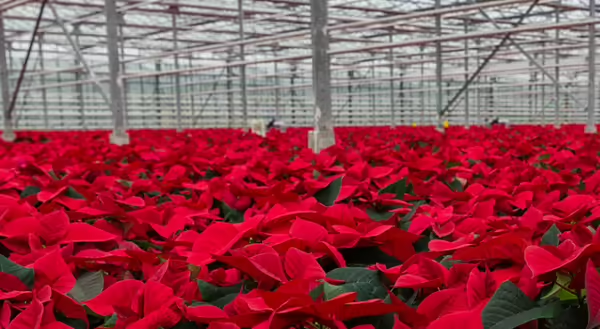
Before I became an educator for the University of Illinois Extension, my career solely focused on growing plants in a greenhouse. High-quality poinsettias were one of the most important crops for a grower. Clients had long-standing orders for these holiday treasures, and expected long-lasting, healthy, bright, bold, and grand plants to decorate their homes, churches, and businesses.
I was assigned to give them the most ideal environment to grow, a task far more complex than other crops grown in the greenhouse. I had to manage the fungus gnats that plague small poinsettia plants that have not yet rooted out and are a bit soggy. By applying a live nematode treatment, I would kill the larvae of the fungus gnats that lived and fed on the small delicate roots in the soil.
I would also water the plants, weighing them to determine the exact time to water and fertilize. If the plants did not dry out completely, I risked rotting the roots.
I also fertilized the poinsettias. If they were too dry, I could not give these heavy feeders the nutrients they needed. But if too much fertilizer was added, it would burn the roots. Thus, I had to test the root area for fertilizer buildup. If the test reading was too high, I would water the plant to drench out the fertilizers.
I measured the height of the poinsettias and applied growth regulators to slow growth if needed. The most ideal poinsettia plant is short and has large bracts. If it grew too tall, the plant would not be considered high-quality and branches would become weak.
It would seem that after so much fuss during the growing process, the care of these plants would be too difficult for a consumer. However, a few easy steps can have your poinsettia plant flourishing through the holiday season:
- Poinsettias stay the freshest in a cool room, away from drafts of heating vents or open doors.
- Temperatures should be no lower than 55 degrees and no higher than 70 degrees. The ideal temperature to keep these plants healthy and colors more vibrant is below 62 degrees.
- Let poinsettia plants dry out between watering. If there is any weight, wait another day to water but do not let the soil recede from the side of the plants.
- Insufficient water and too much water will both cause the lower leaves to yellow and drop. Never let poinsettia plants sit in saucers of water. Do not fertilize while the bracts are in color.